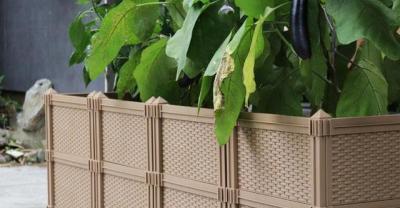Vegetable planting technology on urban balcony
Vegetable planting technology on urban balcony
1 tool selection
The reasonable selection of balcony vegetable planting tools is helpful to improve the work and management efficiency of vegetable growers. According to the summary of relevant experience, it is found that scissors (mainly sharp type), transplant shovel, sprinkler, sprayer (capacity about 1L), bracket, bucket, plastic bag and screen are commonly used planting tools. Reasonable selection can be made according to the planting area and the growth characteristics of vegetable varieties.

(2) Construction of balcony vegetable environment
Growers should choose a reasonable planting time for vegetables according to the actual conditions of the balcony, including closure, sunlight orientation, ventilation, and duration of light. For example, the semi-closed balcony should not be planted in winter; in summer, light treatment should be carried out according to the habits of vegetables.

3 preliminary preparatory work
(1) Container selection. In addition to going to the market to buy certain vegetable planting containers, such as flowerpots and planting grooves, growers can also process and make self-made planting containers based on objects that exist in daily life, such as cake boxes, wooden boards, aluminum suitcases, beverage bottles, plastic boxes, etc., according to the varieties of growing vegetables. At the same time, attention should be paid to drainage when making containers.
(2) Matrix preparation. Soilless cultivation or soil cultivation can be selected according to their own actual conditions, and the substrates for soilless cultivation are mainly nutrient solution and substrates such as peat, bark, water, perlite, etc., and the substrates for soil cultivation are light texture, strong air permeability, comprehensive nutrition, sufficient fertilizer, strong water retention or self-made according to the specific gravity of pastoral soil and rotten leaf soil as 2 ∶ 1 [2].
(3) seed selection and treatment. According to the cultivation area, balcony vegetable planting characteristics and vegetable growth, seeds with small plant type, short cycle, easy to grow and low incidence of insect pests were selected for cultivation, such as small rape, lettuce, pepper, Chinese cabbage and so on. At the same time, in order to improve the growth quality of seedlings and reduce diseases, the seeds can be disinfected by physical or chemical means before planting, such as soaking in hot water (about 60 ℃) for about 12 min, and when the water temperature drops to 30 ℃, take them out and dry them.
4 sprouting and sowing
The seeds that germinate slowly, such as cucumber, pepper, eggplant and celery, can be germinated to shorten the seedling period and improve the growth rate. In general, soaking method can be used to accelerate germination and raise seedlings, for example, cucumber seeds need to be soaked for 1-2 hours, pepper and eggplant seeds need to be soaked for about 4-5 hours, celery seeds should be soaked in 4 ℃ for 24 hours and sowed after germination and whitening.
When sowing seeds, we can use the sowing method to sow leafy vegetables with smaller particles, that is, after the seeds are evenly sown to the substrate, the surface of the seeds is covered with a layer of sifted substrate (about 0.5-0.8 cm in thickness) for compaction treatment. The strip sowing method was used to sow vegetable seeds with moderate particles, that is, according to the distance between the rows of plants greater than 10 cm and less than 15 cm, a sowing ditch of about 1 cm was opened, and after uniform sowing, the vegetable seeds were covered and compacted with the substrate.
Solanaceous fruits or legumes with larger particles were sown by on-demand method, that is, holes were opened according to the distance between rows of plants at a distance of 2 cm, with 2-3 seeds per unit, covered with matrix and compacted. In addition, watering treatment was carried out after the seeds were sown.

5 growth management
With the continuous growth of plants, according to the actual situation and vegetable growth needs, soil cultivation, watering, interseedling, loosening soil, transplanting (support), fertilization, pruning and flower thinning and other treatments are needed to ensure the healthy growth of plants and improve the yield and quality of vegetables [4].
(6) Disease and pest control
In view of the problems of diseases and insect pests in balcony vegetables, we should first find out the causes of the formation of diseases and insect pests, and deal with the existing problems by manual capture, setting anti-insect net, removing disease leaves, using drugs at the source of disease and so on [5].
Vegetable pest identification and control techniques vegetable planting techniques books Agricultural Books practical reference Books vegetable efficient planting Guide ¥16.3 JD.com purchase! function () {if (! window.__TEMAI_PARSED) {if (! window.__TEMAI_PARSED) {if (windows. Responsivevegetables 1 month window.responsive.dprbread vegetables window.responsive.changeScale (1), window.isPGCskills 0 times window.vegetable requestType0 window. "app") {var e = "% 3Cscript%20src=%22 https://s3.pstatp.com/inapp/toutiao.js%22%3E%3C/script%3E";" Document.write (decodeURI (e))} var t=document.createElement ("script"); t.src = "https://s2.pstatp.com/pgc/v2/pgc_tpl/pagelet/card/click_ccce36d.js",document.body.appendChild(t)}}();"
- Prev

The most beautiful camellias are grown by yourself.
- Next

Planting snow lotus fruit has high economic benefit.
Planting snow lotus fruit has high economic benefits. GE Jixin, the development base of snow lotus fruit in Wu'an Town, Yuncheng County, Shandong Province, has achieved a bumper harvest for many years, with a total area of 667 square meters.
Related
- Fuxing push coffee new agricultural production and marketing class: lack of small-scale processing plants
- Jujube rice field leisure farm deep ploughing Yilan for five years to create a space for organic food and play
- Nongyu Farm-A trial of organic papaya for brave women with advanced technology
- Four points for attention in the prevention and control of diseases and insect pests of edible fungi
- How to add nutrient solution to Edible Fungi
- Is there any good way to control edible fungus mites?
- Open Inoculation Technology of Edible Fungi
- Is there any clever way to use fertilizer for edible fungus in winter?
- What agents are used to kill the pathogens of edible fungi in the mushroom shed?
- Rapid drying of Edible Fungi

